Game of the Month: Stranger of Paradise: Final Fantasy Origin
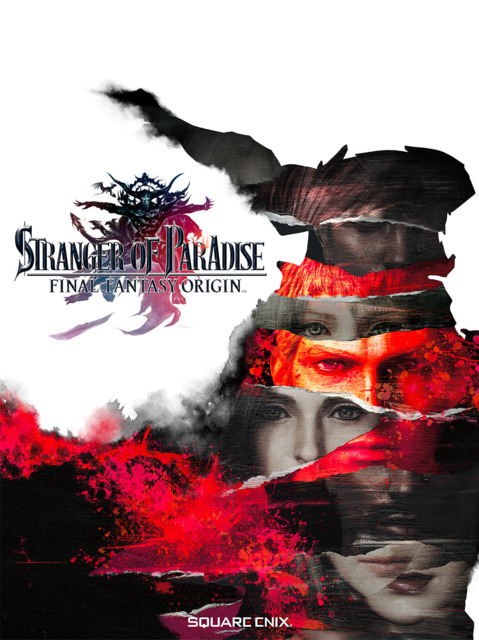
What up my Chaos-hating comrades to another Mento's Month and another game that really represents what I'm all about these days: combining legacy JRPG franchises that I've been playing for literal decades and anything that even remotely resembles a Souls game. Just needs some explormer action in there somewhere and we'll have hit the Mento trifecta. Stranger of Paradise: Final Fantasy Origin is a collaboration between Square Enix and Koei Tecmo's Team Ninja, the latter exercising their particular model of Soulslike that involves a discrete stage-based structure and a whole bunch of colored loot which they debuted with Nioh and perfected with Nioh 2. Playing more Final Fantasy has also become an objective of mine ever since penning this 35 in 35: A Not-So-Final Final Fantasy Retrospective list for the franchise's 35th birthday. Final Fantasy will hit its 37th anniversary at the end of this year so I've been planning various means to maintain this "one played game per year of its existence" quest. The Nioh crossover was the most obvious way I could go about maintaining the ratio for another year, and I've solid enough plans for the next few years too. Thankfully, it's not like the franchise is going away any time soon if the sales numbers of the Final Fantasy VII remakes are accurate, though I'll admit to not being particularly enthralled by the prospect of playing through that game a second time (not that I dislike FFVII by any stretch; its just a very lengthy and memorable enough story that it's going to feel too much like a retread even with all this divisive new alternative story content).
Stranger of Paradise sees the very first Final Fantasy receive a prequel of sorts, but it's not so much a narrative continuation (or pre-continuation, or whatever the prequel term for that might be) but a deconstruction of that game and its surprisingly ambitious story as well as of the franchise as a whole. As the taciturn Jack, an apparent Warrior of Light holding a fated crystal, the goal is to follow the plot of the first game as you hit one temple dedicated to an elemental crystal after another, defeating the fiends that are corrupting their power for their own ends. However, the game is constantly hinting that something is awry with this particular tale, between Jack's flashbacks to an unfamiliar land and the sheer number of extradimensional Final Fantasy (which is to say, not FF1 but FF2-15) allusions. Mostly it's an excuse for a bunch of silly edgelord posturing which just about props up a Kingdom Hearts-level metaverse mindscrew of a story about an advanced society messing around with the world of Final Fantasy I like it was their own experimental petri dish combined with an endless source of natural resources to plunder. Like a Final Frackersy, if you will.
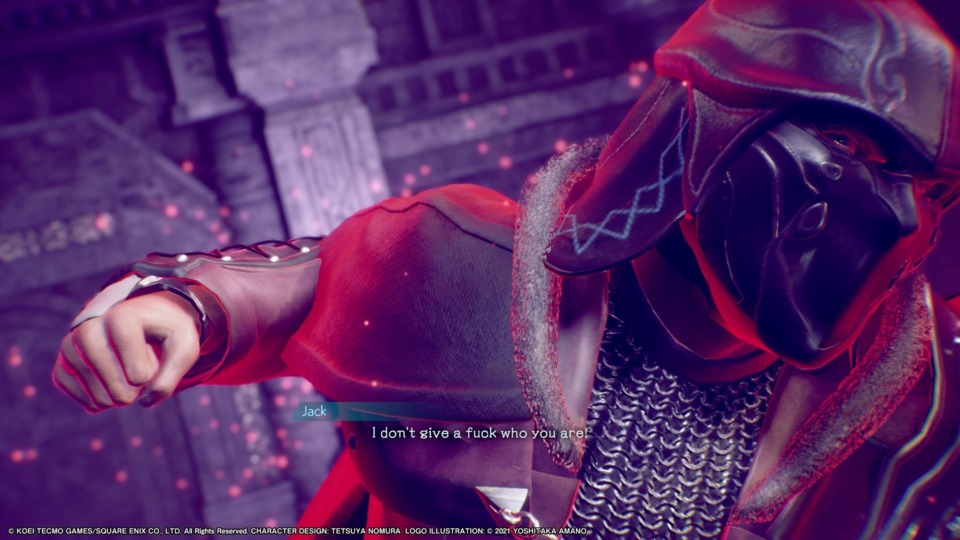
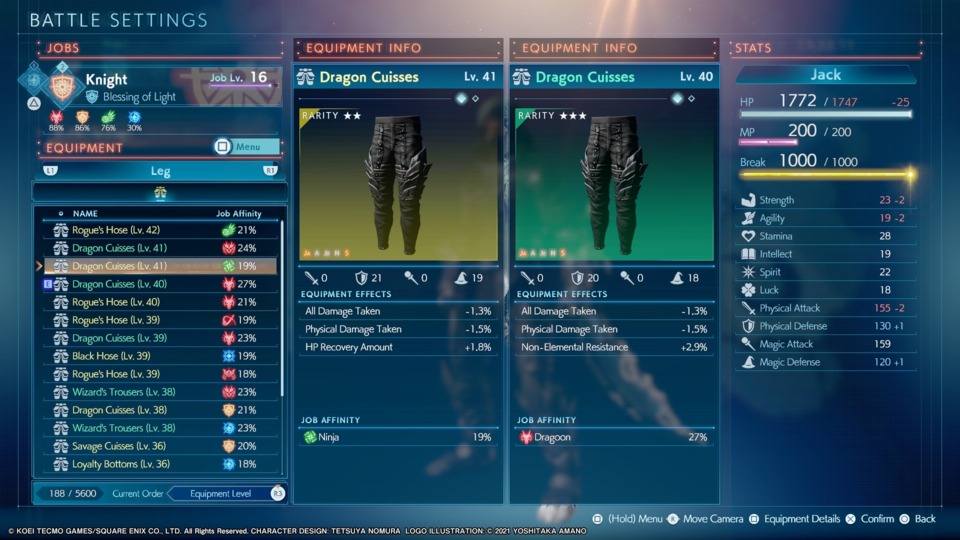
Nioh always had a penchant for loot and featured overly complex character building and combat systems that took half the (very long) game to figure out, and that's what Stranger of Paradise is all about too. Manna for number perverts. Yet there's also an expediency to Stranger of Paradise where you never feel like you're getting an opportunity to feel things out with a new class since by the time the mission's done (provided you have a sufficiently high attunement rating) it's likely you'll have maxed it out or progressed far enough to unlock the nodes needed for the superior advanced and expert jobs: little point hanging around the basic jobs unless you have more of those job nodes to activate.
Stranger of Paradise is to Final Fantasy what Rising: Revengeance was to Metal Gear. In some ways it feels almost like a parody; an overly edgelord mirror put up against the franchise's infamous foibles with regards to its inscrutability that only nominally resembles the original source. However, that funhouse mirror distortion also feels like it has a lot of truth and affection behind it, and as you get further into it the game becomes less like an unkind pastiche and more like an adaptation of some familiar material in the style of an entirely new creator. Metal Gear also had another case of this: The Twin Snakes, which amped up the degree of competence of Humanity's Greatest Soldier to almost ludicrous levels in the hands of a very different kind of auteur. Stranger of Paradise might be narratively bonkers and emotionally discordant but which Final Fantasy isn't, at least some of the time?
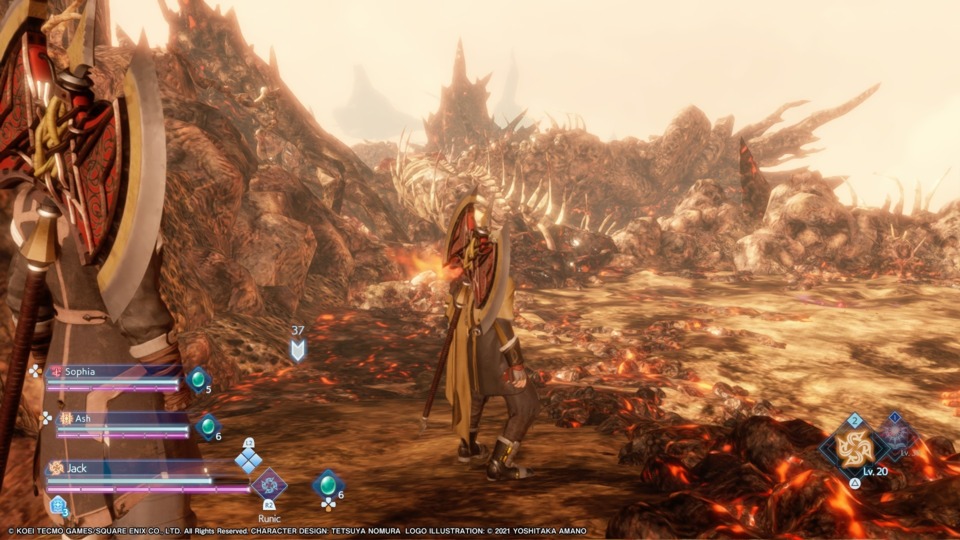
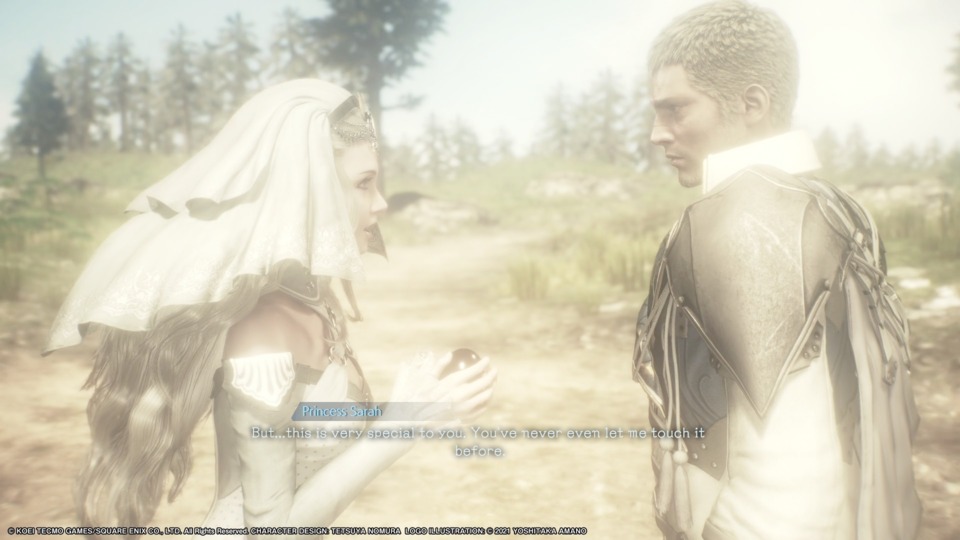
Don't get me wrong, by most metrics Stranger of Paradise is not a great game, let alone a great Soulslike RPG. The loading times on PS4 are abysmal, ironic given that the rough textures makes it look like a PS3 game half the time, and between the sheer density of the features it throws at you from the jump and the obtuse density of its meta narrative it takes a real long while until you're able to match its wavelength and I wouldn't fault a single person who bailed on the game long before they could reach that point. The loot spam is almost out of control: this game is close to doing to loot RPGs what Donkey Kong 64 did to collectathon platformers, with just as many color variants to its tchotchkes. There's also the aforementioned rush through all the jobs, without enough time to fully absorb the approach to using them effectively. Yet, I have to admit that Stranger of Paradise's particular brand of crossover insanity is exactly what I was looking for from both this franchise and format—if not all the time then at least some of the time—since "playing it too safe" is a sin most Final Fantasy games have done a tremendous job in avoiding up until now (even X-2 and the XIII sequels, despite recycling a lot of assets, were so damn weird both structurally and narratively to compensate). (Rating: 5 out of 5. Yes, I'm crazy.)
(Plus, Stranger of Paradise really does know its FF lore: For instance, there's a side-quest inside a dungeon inspired by the tomb from Final Fantasy XII where you have to open random chests hoping to locate the one containing a specific spear. I found that very amusing.)
Darling Indies and Other Gaming Tomfoolery
Pictlogica: Final Fantasy
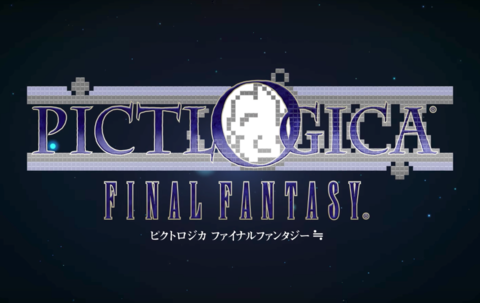
What else have I been playing in March? Well, I'm ashamed to admit this, but I fell into a deep P-Hole this month. That is to say, a picross hole. (There's probably a better way of phrasing that.) Continuing the above theme of pursuing a personal goal of playing one Final Fantasy game per year of the franchise's existence, Pictlogica: Final Fantasy is a F2P 3DS picross game devised by Square Enix and picross Picassos Jupiter Corp that functions similarly to their later F2P Pokémon Picross in that you can absolutely play it for free but it'll just randomly insist on making you wait for long stretches unless you fork up a small fee to hurry things along. It's one of the more obnoxious developments in the F2P market that'll have you wishing for a season pass, but it suits my purposes since I'm fine with playing picross games stretched out across a long duration. I tend to get too attached otherwise, as I'll get into in a moment.
Like Pokémon Picross (or similar FF spin-offs like Theatrhythm), Pictlogica found a novel and germane way to integrate standard Final Fantasy RPG aspects such as character progression, party dynamics, and tactical real-time battles. Occasionally, when you complete a picross and it happens to be the portrait of a playable character, you can take part in a "quest" where you have to defeat several waves of enemies followed by a boss to unlock that character for use. You do this with a team comprised of your currently available characters, which you can level up with special gems you collect by completing conditional goals when taking on the regular picross mode (where the assignment might be "turn the assist modes off" or "complete under this time") and the quest mode ("complete the battle with only sword-users/female characters/fewer members than usual"). Levels are capped until you make further progress in the game, and there are battles which are way too tough for your current party that often involve recruitable villain characters like Golbez and Gilgamesh, so there's spots where you might need to come back later for a particularly tough playable character recruitment quest. I've been gravitating towards my personal favorites when it comes to the party, but there's a few like Bartz (who cares about Bartz?) where I'm motivated to keep them around because of their useful skills—he has a strong opening attack called Barrage that activates whenever you use him first. The way these battles work, incidentally, is that they generate little five-by-five picrosses that you're meant to complete as quickly as possible: keeping up a decent pace without making mistakes quickly increases a "break" gauge that, when reached, causes additional damage to monsters with your attacks similar to how the mechanic is employed in Final Fantasy XIII and a few later games.

Between those artificial timers meant to gouge money from impatient players and just the way I tend to approach picross games in general, I imagine I'll be chipping away at Pictlogica for a while to come yet rather than hashing it out across a handful of lengthy sessions. Once I finally exhaust its content I'll be relieved (in maybe an odd OCD way) to update my "35 in 35" list to a "37 in 37" one. Those numbers gotta match, man, they just gotta. (Rating: 4 out of 5.)
Continuing to push even further down my P-Hole, I've also been playing a fangame called Zelda Picross. Now, this is not the Zelda Picross that Nintendo themselves put out on 3DS exclusive to My Nintendo patrons to celebrate the release of Twilight Princess HD for Wii U, but rather one devised by Zelda fangame creator Vincent Jouillat as a spin-off of sorts to his series of A Link to the Past ROM hacks. It borrows the graphics of that venerable SNES paragon here too, only in the service of around a couple hundred picross puzzles. It's a fairly ingenious take on both The Legend of Zelda and picross in how it'll block off areas of dungeons and the overworld until you have the right item or a necessary key, but at almost all points there's usually more than one path to keep exploring if a path is blocked. Some upgrades open up routes where you can proceed further (like the hookshot or bombs) but others (like the Pegasus Boots or Book of Mudora) provide features to make the puzzles easier instead as they ramp up in size and difficulty.
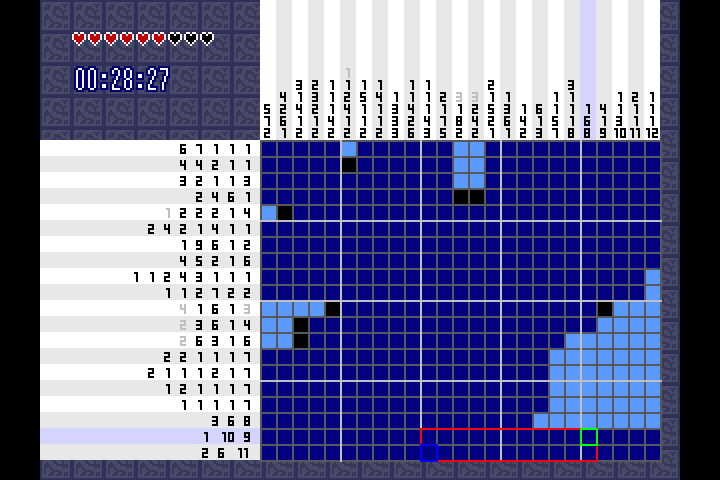
There's both a time limit and a mistakes limit while playing, the latter being Link's usual stock of hearts (which, of course, can be upgraded), and there's some real nice QoL features for the picrossing itself. One such example, and one I don't think I've ever encountered before, is being able to draw boxes around multiple squares at once like cells on an Excel sheet and either make them all positives (definitely part of the image) or negatives (definitely not part of the image), and that convenience can really help when the timer's looming over you. I still of course prefer no timers and letting the player screw themselves over by never correcting their mistakes, which I call "Wario Mode" after the same model in the Mario Picross series, but I can't fault how this system is utilized here. A surprisingly solid picross game and Zelda game alike—though granted it looks cheap as heck given it's made out of recycled sprites—and worth a recommend if you like either. Though, yeah, I'll admit to kinda getting hooked to it—I think I would've been done with Stranger of Paradise a lot sooner if I hadn't been so distracted with its numerical charms. (Rating: 4 out of 5.)
Oh yeah, @gamer_152 mentioned the chill bee-searching game I Commissioned Some Bees 0 in his last Lo-Fi Plays column so, since it's free, I also downloaded it and gave it a spin. The Where's Waldo genre's really taken off on Steam in the past decade or so and there's been no shortage of games where the developer just paid some artists for busy pictures of crowds and then sprinkled in a random assortment of crap for players to find. Not that I'm insinuating that this game, or the thirty or so others the dev has published on Steam in the past couple of years, didn't take a long time and much consideration to produce. Still, video games are often about realizing the sort of fantasy experiences that couldn't be recreated in the real world, and I'd say "poking hundreds of bees and not dying" is certainly one of those.
WonderSwanning, Mega Driving, and Sixty-Forging Ahead
Let's check out the retro corner for this month. Hmm, yes, very old and mostly irrelevant. But enough about me, let's review all three of these regular features and see what's developed. First, our new feature that explores the mysterious WonderSwan—which I ruefully named Anyway, Here's WonderSwan without realizing I'd get that awful song in my head every time—processed and ranked another five games with a surprisingly positive result of three games I could just about follow to two that remained inscrutable due to the language barrier. Tweaking that ratio is really going to be a driving force of this feature, I suspect: I've already pored over a full master list of games for the system and, oof, maybe I would've reconsidered a few things given how many of them are text-dense RPGs, strategy games, and graphic adventures. I think it's safe to say that I completely missed the turning point when many handheld systems became dedicated RPG devices (the Vita being perhaps the most prominent example); since I don't care for playing long-session games on handhelds due to eye/hand strain it's certainly not something I'd really registered before now, but this era in time looks to have been the start of that shift. Even so, I'm having a great deal of fun unearthing all the WonderSwan's hidden treasures and will remain indefatigable in navigating its choppy anime tie-in waters to reach them.
The Mega Archive polished off October 1993 and entered November and the holiday rush of thirty years hence in earnest. We'll be stuck in the release windows of November and December for quite some time yet, and this coming month won't see us move through that list any faster as we'll be taking another break to investigate the Sega CD's no doubt fuzzy Halloween period instead. Highlights... hmm... highlights, you ask? Well, there was Columns III. I didn't know that there was a third Columns, so that was exciting to find out. I guess. I enjoyed ripping into the flagrant clone that was Awesome Possum Kicks Dr. Machino's Butt and its preachy environmentalism; I might go so far to suggest that recycling should probably end at glass and plastics and not the intellectual properties of others. The actual best game of that group was almost certainly Disney's Aladdin, being the polished platforming classic that it is, but the dark fantasy pinball sequel Dragon's Revenge seemed like a valid contender too.
Finally, we have this month's episode of 64 in 64. Similar snag here as with the WonderSwan feature in that I bumped into one of the very few N64 games that required a high degree of Japanese literacy to enjoy, given Yakouchuu II: Satsujin Kouro is a visual novel, but all the same it's the only game of its type for the system so for the novelty factor alone I was eager to give it a try regardless. You can see how well I struggled with some translation woes by checking out that episode. The other game, selected by me, also indirectly homages that WonderSwan feature somewhat in that it's a fun (albeit in short sessions) puzzle game of the type that has (so far) been the best the WS has had to offer. Bust-a-Move '99—or Bust-a-Move 3 DX or Puzzle Bobble 64 depending on your territory of origin—sees Taito's bubble-bursting, accuracy-demanding series make its second appearance on the N64 and was surprisingly packed with content given how relatively shallow most block-stacking puzzle games of the era tended to be.
Your hint for the next 64 in 64 pair: The pre-select pick is a game I've referenced in over half the episodes so far, while the random pick is yet another untranslated JP exclusive I'll have to feel my way through (but given its subject matter I imagine I'll do just fine this time).
The "Indie Game of the Week" of the Month: Turnip Boy Commits Tax Evasion (Snoozy Kazoo, 2021)
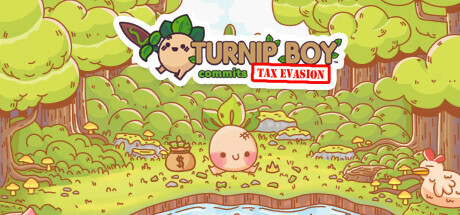
Super close-run thing this month, since all of the IGotWs were strong "four out of five"s: exceptional games that were just missing out on true greatness due to one drawback or another. Turnip Boy Commits Tax Evasion (#360) takes the crown this time just because it had some unanticipated depth to what looked, at first blush, like a meme-y Zeldersatz. In retrospect, the Undertale comparison was apt: that game captured the imaginations of those that played it due to its emotional depth and sometimes dark and sometimes hopeful twists, but since everyone walked away from that game convinced they'd experienced something special that they'd never want to spoil for others (beyond, "hey play this game") it ended up having its dumber and less essential moments turned into references that could be shared between the faithful and outsiders alike. I could see Turnip Boy having the same kind of internet presence had it been a skosh more substantial, but even as a lesser product it proved to be a similarly potent package of a great and bizarre soundtrack, some decent puzzles to decipher, and some wraught moments I definitely did not see coming in a jokey game about a felonious vegetable.
As to the runners up, we have a pretty solid "exploraction game" ("explormer" wouldn't really work in this case) Depths of Sanity (#359) which has the more uncommon free-movement approach seen in other sub-aquatic games like Aquaria and Song of the Deep. Bit more of a story focus as you delve deep underwater into what is essentially R'lyeh to find out what happened to your submarine crew of misfit The Abyss scientists and engineers; everything outside of that was decent too, from the exploration to combat, though graphically it was a bit underwhelming.
We also had This Way Madness Lies (#361) a typically excellent example of Zeboyd's compact 16-bit JRPG throwback design at work. Maintaining the comedic flair they're best known for, they dip into Shakespeare's works to create a magical girl pastiche where the heroines from those plays live their lives as regular highschool girls one moment and then magically change to fight monsters in other dimensions the next. Definite "monster of the week" flavor to its episodic approach and some catchy VGM with lyrics, building on the musical aspirations exhibited in Cosmic Star Heroine's memorable set-piece with the live band performance. Really, though, the star of the show is how the meta seems to change after every battle, as characters learn new skills and passives that focus their strengths elsewhere, meaning your approach to their role in combat could shift by the minute. It's an impressive feat of "ADHD RPG design" and continues to be Zeboyd's most prominent contribution to the throwback RPG market.
Finally, we have the vaguely antagonistic physics platformer I Am Fish (#362) that tasks you with escorting four fishy friends to the ocean by fishhook or by fishcrook. The game never stops throwing inventive scenarios at you that test your skills and patience alike, though the frequent physics engine "boo-boos" can really throw a spanner into any carefully conceived plans: trying to speedrun the game for the time trial achievements is often an irritation due to this engine's mercurial whims. I did eventually discover the "next checkpoint" button: this will void any time trial scores you were trying to earn, but is at least helpful for grabbing missing collectibles or the more stage-conditional achievements—or, if you're a casual player, skip the sequences that you simply don't have the energy left to take on after so many failed attempts. Think of it like those EA Trials games, only with more guppies rolling around in fishbowls.
(I still have one more IGotW for March but I'll punt the post-script for that into next month's edition of this feature. Kinda like when a game arrives in December too late for the GOTY deliberations.)
The Bonus Indie: The Looker (Subcreation Studio, 2022)
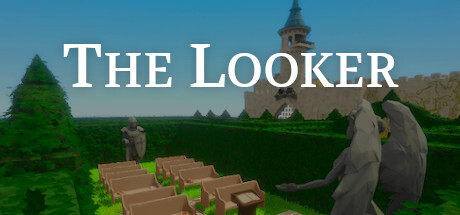
As ever, the Bonus Indie is a place where I can stash indie games that wouldn't really fit the IGotW feature for one reason or another. In The Looker's case, that's because it's an elaborate hour-long shitpost at the expense of Thekla's The Witness. You might even say it's the modern equivalent of Pyst: the idea being to take a first-person puzzle-adventure game with, let's say, a certain amount of pretension and then replace all instances of erudition with crude jokes and sarcasm. That said, The Looker does a few similar "thinking outside the box" puzzles that not only elevates it closer to "actual game" status but would also suggest the developer aimed for this to be a bit more of an affectionate parody than it would first appear.
In The Looker you're dropped inside a futuristic tunnel that leads out into a medieval courtyard filled with monitors plugged together in a daisy chain series. Each monitor only comes alive when the previous one in the chain has had its puzzle completed: invariably, these puzzles involve drawing one continuous unbroken line from a start point to an end point (or the end point to the start point, if you're feeling nasty). The puzzle difficulty isn't as humorously easy as it initially seems and the game will still throw the occasional melon-scratcher your way. One instance in particular required me to take notes about specific symbols, which was a level of investment I didn't anticipate from a parody game. That said, it's about a fifth the length of The Witness and really only exists to deliver some goofs at Mr. Blow's expense for the most part. The parody element is felt (or rather, heard) most keenly through the audio logs lying around: in the original game they were quotes from famous geniuses or classical literature, whereas here they're mostly specious stream-of-consciousness ramblings that only vaguely resemble something an academic might say.
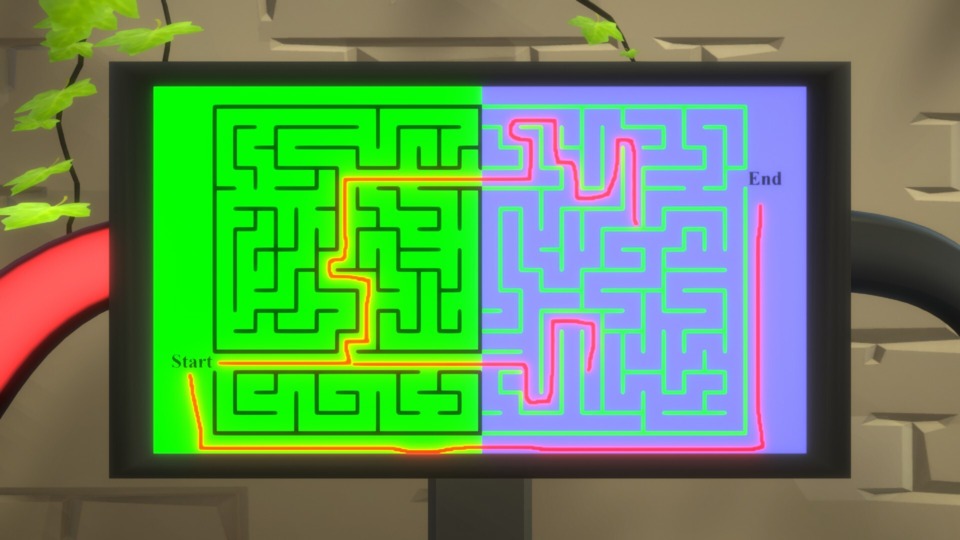
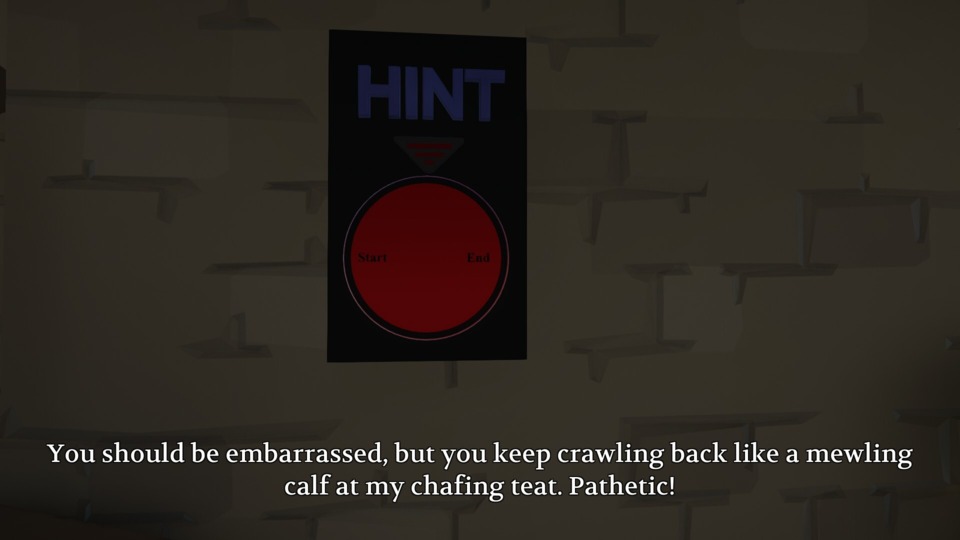
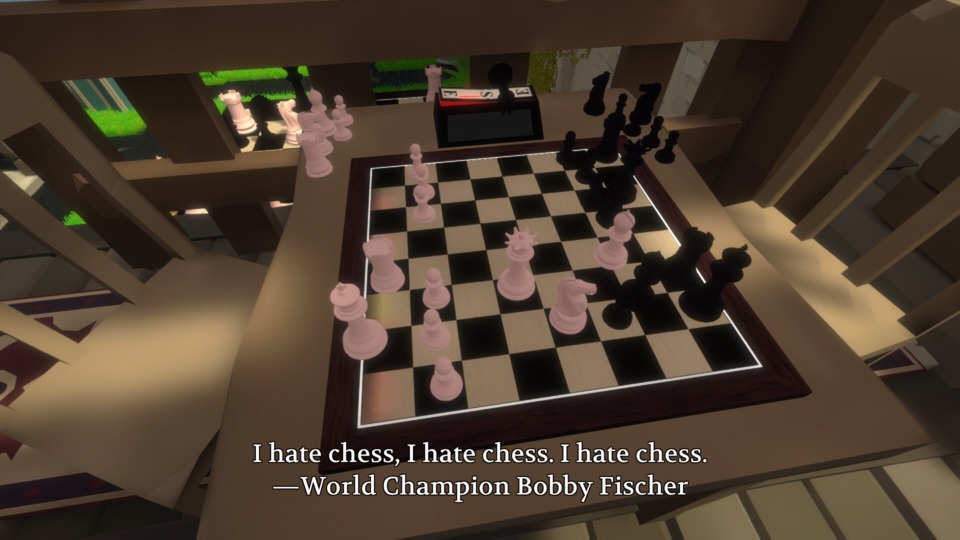
I actually found the game pretty funny for the most part, though most of that comes from my antipathy towards The Witness and its barfy lack of UI, and the puzzle variety turned out to be surprisingly involved. One memorable instance has you playing a version of Snake (called Snek, because internet) with the same rules as the other line puzzles, which required some expert-level Snake strats to solve. Given the game is free, it practically serves as an elucidating demo for what The Witness is all about so I hope Blow's team didn't take too much offense to its (mostly) gentle ribbing. It's a whole lot better than Pyst was, at least. (Rating: 4 out of 5.)
The Weeb Weeview
This month on the Weeb Weeview: Cute shit. Promised, delivered.
Fluffy Paradise
First up is Fluffy Paradise, an isekai about a tired office lady who collapses from exhaustion (the truck drivers union was on strike, I guess) and wakes up as Neema, the newborn daughter of the noble Osphe family. Her wish for her new life is to be surrounded by "mofu mofu": fluffy animals she can hug to her heart's content, and it helps that her new kid form is exceptionally cute enough that beasts and people alike are naturally drawn to her Disney-style. We do get a lot of cute animals—and not just fluffy ones either; one of the first animals Neema charms is an enormous ancient dragon—though the show's kinda weird about determining how precocious an adult trapped in a child's body would be. Sometimes she's clearly sharper than the average 3-5 year old but other times she's entirely at the mercy of our own childlike whims—I guess the show excuses this as being an adult consciousness in a child's brain, prone as it is to doing whatever the hell it feels like no matter how petty or self-injurious.
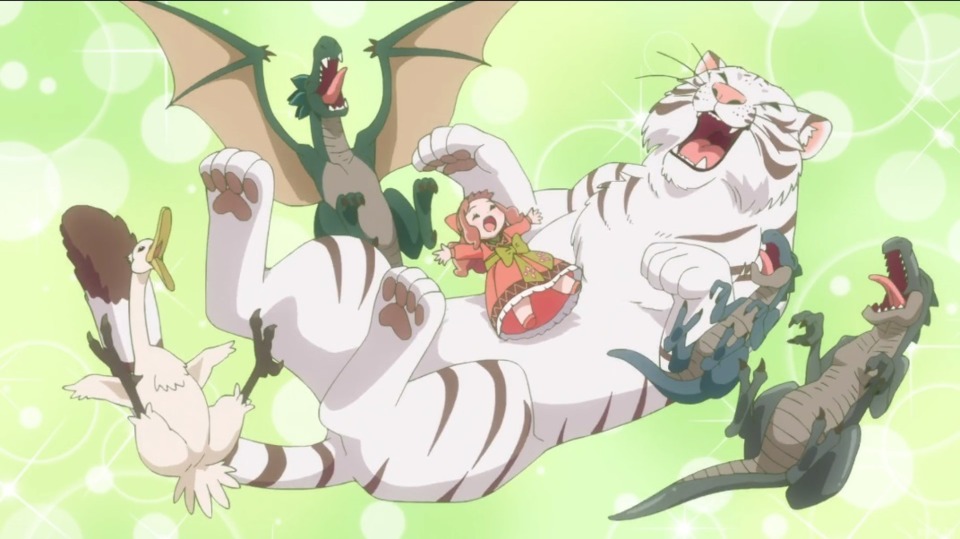
The show's kinda interesting in how it recontextualizes Neema's wish from "cute animals to pet, plz" to "savior of the noble monster races through her endless reserves of empathy and goodnaturedness", which I guess would need to be the hook given the genre and how there'd be too little conflict otherwise, but towards the end of the season she's some iconic freedom fighter rallying various monster tribes together in the face of their human oppressors and I'm left wondering how the character went from a cute animal lover to Susan B. Anime. I guess people can have multitudes. Anyway, even when fluffy kobolds are dying left and right defending their homes the show mostly keeps on message about being goshdarned adorable. Curious to see if a second season ever surfaces and whether it'll lean harder one way into this dynamic or the other.
The Dangers in My Heart (Season 2)
Dangers in My Heart returned fairly quickly after its first season last year, and once again sees emo short king Kyotaro Ichikawa grow even closer still to his tall, glamorous, but mostly just an airhead classmate Anna Yamada. The show established the pair's unlikely but natural chemistry across the first season, justifying how the two might enter each other's orbits due to their various quirks and strengths aligning the right way (I made this sentence unnecessarily lewd), and the second season see them edging (I swear I'm not doing this on purpose) ever closer to actually dating. That's about it for the story, by the way: these school day romance stories tend to be mostly slice-of-life character studies more than something with an elaborate overarching plot to follow.
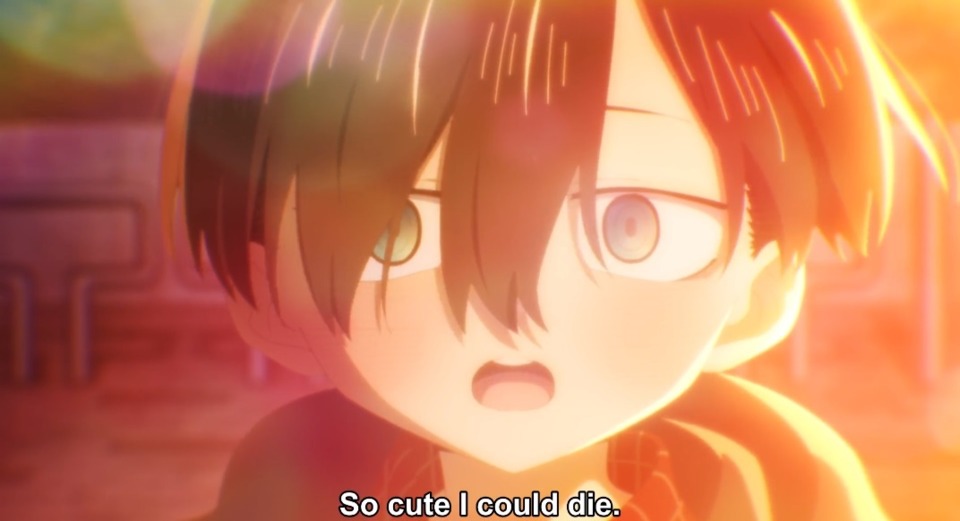
It's hard to describe exactly what makes this show so endearing. Partly it's the two leads; as is typical for shounen romance anime, the male lead is a relatable self-defeating nobody unable to appreciate his low-key qualities (the usual "be nice to girls" once again winning the day, though again the show sells it pretty well) while the female lead is an impossibly charming fruitcake who is defined mostly by her naivety, clumsiness, and bottomless stomach but also a sweetness that is occasionally a source of misery for her, as she hates feeling like she's let other people down. It's also just really well paced and animated, deeply sincere, occasionally funny (mostly the contributions of side characters, like Ichikawa's perverse moron sorta-friend Shou or his meddling older sister Kana), and nails the awkwardness of adolescent love in a way that doesn't feel pandering or demeaning or overly precocious. S'cute. Also why it's here this month.
Mr. Villain's Day Off
Mr. Villain's Day Off simply follows the daily routine of the evil overlord of an extraterrestrial group of invaders looking to conquer Earth, frequently having to fight off the Super Sentai-esque hero group that thwarts their attempts. When he's not doing that, though, he's a huge fan of pandas—the only creature he intends to keep alive once his organization's fully taken over—and goes to see them at the zoo in his limited amount of free time. He also eats a lot of panda-shaped food and collects panda , and has started to become fond of other Earth animals. Pretty similar pitch as that Too Cute Crisis show from last autumn but far less wacky and animated; Mr. Villain is rarely a histrionic sort and approaches his passions with the same measured calm he approaches his battles with Earth's heroes.
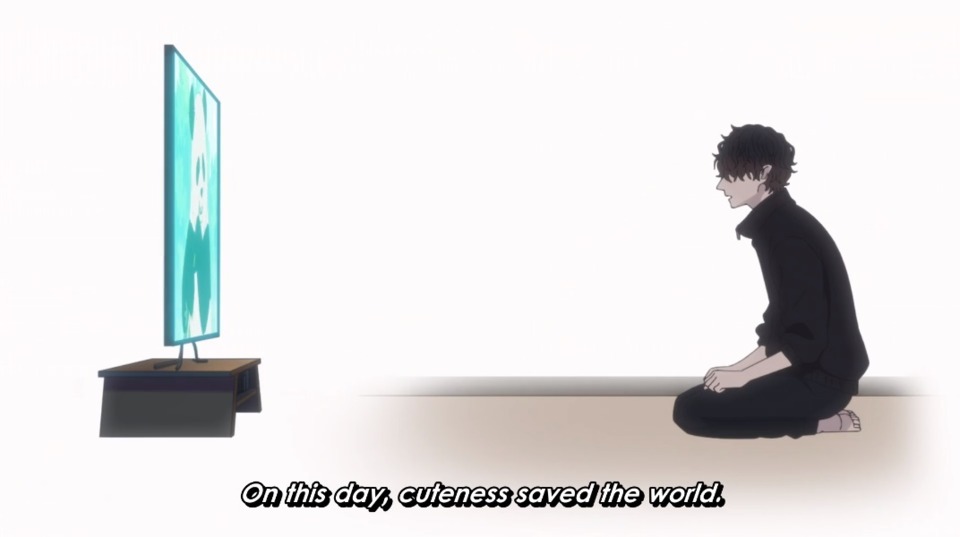
I've only seen a few episodes of this show so far but its the real languid pace serves its deadpan humor as the villain finds ways to be less villainous every time he appears. The show also explores how he gets closer, in a manner of speaking, to the heroes as they also spend time off from superheroics in their casual clothes. The show's been slowly developing the people in Mr. Villain's orbit, from subordinates to antagonists, and how his desire to crush everything before him and laugh over the burning remains of our frequently irksome civilization (he's irritated by a lot of everyday things, only encouraging his war further) is mostly for those days when he's "on", and the days when he's "off" is mostly about eating ice cream and watching nature documentaries about pandas. I've been meaning to go back to it: now that we're in the last week of this "cour" and at least half the season's shows have ended already, it might be a prudent time to catch up.
Before wrapping this up, let's talk about some of the previous shows I've brought up on here now that they're close to finishing their current seasons (with one exception):
- Solo Leveling continues to be extremely entertaining. The fight with Igris in the season's penultimate episode was one of the most electric things since, well, the last big fight scene in Solo Leveling I guess (also, best protag juggle since Pierrot le Fou). It's getting me back into hyperactive (and hyper-animated) shounen again. The series-pivotal event in the next and final episode of the season is going to explode some brains and I can't wait to see those reactions.
- Delicious in Dungeon is entering its second cour and will be around in spring too, so I can't speak on its overall arc yet. Seems like the current situation will cause the quest to shift direction somewhat but for now I'm content with it being a gently amusing hangout show about cooking monsters and running afoul of various D&D tropes.
- Frieren: Beyond Journey's End ended on a high note and now that it's officially the highest rated show on MyAnimeList I suspect the animation studio will be working on the next season. Seems like there's some demand at least. I know some folks were less than enthralled with the mage examination arc but it gave the show an excuse to expand its cast severalfold and to see how modern magic has changed since (and because of) Frieren's heyday. There's a certain evenly-matched mage battle during that arc with some insanely great animation, the sort where the creative team just let their imaginations run wild with visual effects akin to the dimensional stuff in the Spider-Verse movies, so I'm hoping they have more opportunities to flex those muscles in the next season.
- Villainess Level 99 just kinda fizzled out in a flash—I guess the anime studio figured a second season was out of the question, so they wrote an alternative ending that was a bit nicer and more definitive than the LN's—but I still dig the pitch of "what if Daria was also Ultima Weapon and how would that affect her already miniscule HS social cachet?" and it did do some cute stuff with protag Yumiella and her obliviousness regarding her beau Patrick's overt feelings for her. But yeah, everything kinda got settled in a hurry with those last two episodes and I doubt we'll see a follow-up. I'm still on the look out for any isekais that double as deconstructions of video games—ideally with the levity such a concept deserves—but then I do also have a fondness for predictable anime trash (and I mean that in an affectionate way, like how the Mother's Basement YT channel uses the term). Just something to stick on while I eat dinner, you know? S'fine.
- The Wrong Way to Use Healing Magic had been pretty interesting as an isekai that avoided many of the usual tropes that tend to bring those of its genre down, so it's a little dispiriting that the big villain of this season is now shaping up to be a second (or possibly third) love interest for the protag. These things don't always have to turn into harems, you know? But nonetheless, it looks to be largely done with the current demon war storyline and plans to explore some other territories in season two, maybe expanding Usato's perspective a little more in the process. Dunno if we'll get an international conference of healers or what, but I'm always down for some worldbuilding and road-trip bonding.
- My Instant Death Ability is Overpowered had some real crappy pacing towards the end there due to squeezing in too many manga volumes at once but at least it ended on a semi-decent note that, as is often the case in this unpredictable market, could work as ably as a series finale as it does a season finale. There's an arc they had to cut out which I hope they get back around to somehow—it doesn't really fit into the overarching plot, so I could see why they'd cut it, but it's also a really neat (and deeply disturbing) mini-narrative about the main character's ability's "reach"—so maybe they can turn that into an OVA to hype up a second season or something. Overall, I wish it could've been better but it's still a fun property and concept that I'll probably continue to follow via the manga.
I also said something about rating the opening themes of this season's anime last time, so here's my five favorite ranked (granted, there were many shows I did not watch):
- Solo Leveling ("Level")
- Shangri-La Frontier ("Danger Danger")
- Villainess Level 99 ("Love or Hate")
- The Wrong Way to Use Healing Magic ("Cure")
- Mashle Season 2 ("Bling-Bang-Bang-Born") (I don't know why I picked this)
Log in to comment